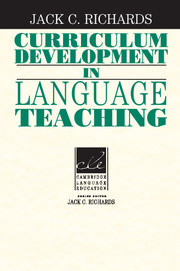Book contents
- Frontmatter
- Contents
- Series editor's preface
- Preface
- Credits
- 1 The origins of language curriculum development
- 2 From syllabus design to curriculum development
- 3 Needs analysis
- 4 Situation analysis
- 5 Planning goals and learning outcomes
- 6 Course planning and syllabus design
- 7 Providing for effective teaching
- 8 The role and design of instructional materials
- 9 Approaches to evaluation
- Author index
- Subject index
7 - Providing for effective teaching
Published online by Cambridge University Press: 03 May 2010
- Frontmatter
- Contents
- Series editor's preface
- Preface
- Credits
- 1 The origins of language curriculum development
- 2 From syllabus design to curriculum development
- 3 Needs analysis
- 4 Situation analysis
- 5 Planning goals and learning outcomes
- 6 Course planning and syllabus design
- 7 Providing for effective teaching
- 8 The role and design of instructional materials
- 9 Approaches to evaluation
- Author index
- Subject index
Summary
Curriculum development processes as they have been described so far in this book are essential resources in helping schools achieve their goals. The other principal educational resource is teaching itself. The focus of this chapter is how quality teaching can be achieved and maintained in a language program. Whereas the preceding chapters have described some of the essential planning that is involved in developing a language course, the present chapter seeks to examine factors that are involved in creating conditions for good teaching to take place. Quality teaching is achieved not only as a consequence of how well teachers teach but through creating contexts and work environments that can facilitate good teaching. The following issues will be considered in this chapter:
• institutional factors
• teacher factors
• teaching factors
• learner factors
The institution
The organizational culture
The organizational culture of a school refers to the ethos and environment that exist within a school, the kinds of communications and decision making that take place, and the management and staffing structure they support. In Chapter 4, several aspects of a school's organizational culture were discussed, including the extent to which the school's organizational culture facilitates or hinders the reception of new ideas and practices. A school's organizational culture is revealed in the way the following questions are answered:
• What are the school's goals and mission?
• What is the school's management style?
- Type
- Chapter
- Information
- Curriculum Development in Language Teaching , pp. 198 - 250Publisher: Cambridge University PressPrint publication year: 2001

